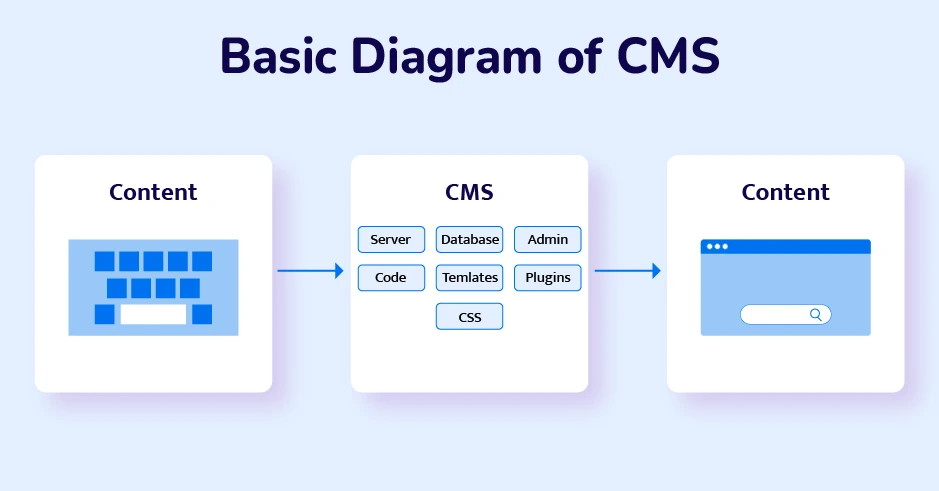

In today’s digital world, content plays a crucial role in connecting people and ideas. CMS helps everyone, whether tech-savvy or not, easily shape the digital world without needing advanced programming skills, making it essential.
This blog explores the types, features, and advantages of CMS, emphasizing its user-friendly nature and diverse applications. Content Management Systems, whether open source or proprietary, makes creating and organizing digital content easy and affordable, playing a crucial role online.
Content is stuff we make to share and understand things like words, pictures, and videos. Think of it as what you see on websites, social media, and online places. We share and connect with people by putting out information and enjoyable content.
A Content Management System (CMS) is like a tool for making and arranging digital content. however, It makes it easy for people, even those not great with tech stuff, to update and keep web pages fresh without needing to know a lot about programming.
Content Management Systems (CMS) are tools that help people easily create and manage digital content on websites. Moreover, Here are some of the types of CMS:
Open Source CMS:
Examples: WordPress, Joomla, Drupal.
Proprietary CMS:
Examples: Adobe Experience Manager, Sitecore.
Headless Content Management Systems:
Examples: Contentful, Strapi.
Enterprise CMS:
Examples: SharePoint, Oracle Content, and Experience Cloud.
Web-based CMS:
Examples: Wix, Weebly.
Document Management System (DMS):
Examples: M-Files, Documentum.
In addition, These tools help with various things, like writing personal blogs or handling a lot of content for big businesses, offering different ways to manage digital stuff.
A CMS makes it easy for people to create, change, and organize stuff on websites. However, You can add, edit, and handle content without being super techy. It helps keep websites running smoothly, lets people and CMS work together and makes sure things look the same on all devices.
Content Management Systems (CMS) usually have features that help people easily create, edit, and organize content on websites. In addition, Here are some of the key features of the CMS:
Content Management Tools (CMTs) are computer programs that help organize, create, and share digital content easily, making it simple for people and businesses to manage their work efficiently. In addition, Here are some of the CMS tools:
Open Source CMS:
Proprietary CMS:
Ultimately, Pick the content management tool that fits your needs, like the kind of content you have, and how you work together. Moreover, it can grow with you, and how well it connects with your other tools.
Content Management Systems make it easy for people and groups to manage digital content by providing simple tools and organization features for efficient handling. However, Here are some key benefits:
A CMS has three parts, a place to store content, a tool to edit it, and a way to show it. The database holds text and media, the interface helps manage content, and the server fetches data for smooth content delivery.

However, This setup makes it easy to organize and edit content on websites or digital platforms. In addition, Here is a simple diagram of how a CMS works:
A Content Management Systems makes building and managing websites easy. Generally, It is a simple tool for editing content, lets many people work together, and helps grow the site easily. Ultimately, It also has built-in SEO to help the site show up on search engines. Using a CMS saves time and makes website management simple.
In conclusion, a Content Management Systems (CMS) is a crucial tool that helps easily create and organize digital content. Generally, It makes building websites, changing designs, and adding features simple. However, People love using it because it’s easy, flexible, and great for working together on websites and online projects.
Ans. Install CMS on a web server, log in to the admin panel, add content, and tweak layouts. Particularly, Use the dashboard to handle pages, media, and users. Keep your CMS updated and backed up for smooth performance and security.
Ans. Choose the best CMS for your needs in 2023. WordPress is easy and versatile, good for many. However, Drupal handles complex sites well. Joomla offers a balance of power and user-friendliness. Generally, Look at functionality, scalability, and community support to make the right choice for your project.
About The Author:
The IoT Academy as a reputed ed-tech training institute is imparting online / Offline training in emerging technologies such as Data Science, Machine Learning, IoT, Deep Learning, and more. We believe in making revolutionary attempt in changing the course of making online education accessible and dynamic.

Digital Marketing Course
₹ 9,999/-Included 18% GST
Buy Course₹ 29,999/-Included 18% GST
Buy Course